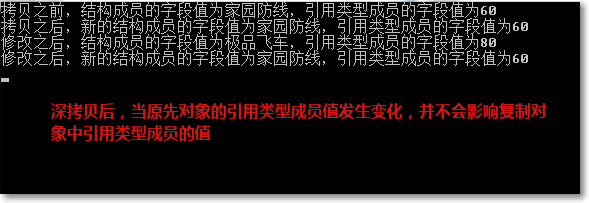
Sometimes, we need to read data from the database to fill the object or read the file from the hard disk to fill the object, but this is relatively time-consuming. At this time we think of copying objects. This article analyzes the usage of C# shallow copy and deep copy in the form of examples. The details are as follows:
1. Shallow copy
1. What is "shallow copy":
When copying an object in advance, for the value type members of the object, Will copy itself, for reference type members of the object, only copy the object reference, this reference points to the object instance on the managed heap.
2. There is an object that contains class members of reference type and struct members of value type
Cinema contains reference type member Room and value type member Film.
public class Room
{
public int _maxSeat;
public Room(int maxSeat)
{
this._maxSeat = maxSeat;
}
}
public struct Film
{
public string _name;
public Film(string name)
{
this._name = name;
}
}
public class Cinema
{
public Room _room;
public Film _film;
public Cinema(Room room, Film film)
{
this._room = room;
this._film = film;
}
public object Clone()
{
return MemberwiseClone(); //对引用类型实施浅复制
}
}3. Test the effect after copying
①Print out the values of the value type and reference type members of the original object before copying
②Copy the original object, Print out the values of the value type and reference type members of the copied object
③ Change the value of the original object and print the value type and reference type members of the original object again
④ Print the value type and reference type members of the copied object again Value
static void Main(string[] args)
{
Room room1 = new Room(60);
Film film1 = new Film("家园防线");
Cinema cinema1 = new Cinema(room1, film1);
Cinema cinema2 = (Cinema)cinema1.Clone();
Console.WriteLine("拷贝之前,结构成员的字段值为{0},引用类型成员的字段值为{1}", cinema1._film._name,cinema1._room._maxSeat);
Console.WriteLine("拷贝之后,新的结构成员的字段值为{0},引用类型成员的字段值为{1}", cinema2._film._name, cinema2._room._maxSeat);
//修改拷贝之前引用类型的字段值
cinema1._film._name = "极品飞车";
cinema1._room._maxSeat = 80;
Console.WriteLine("修改之后,结构成员的字段值为{0},引用类型成员的字段值为{1}", cinema1._film._name, cinema1._room._maxSeat);
Console.WriteLine("修改之后,新的结构成员的字段值为{0},引用类型成员的字段值为{1}", cinema2._film._name, cinema2._room._maxSeat);
Console.ReadKey();
}Analysis:
The key point of shallow copy is that the object reference copied to the reference type points to the object instance on the managed heap. Changing the value of the original corresponding reference type will affect the copied object.
2. Deep copy
1. What is "deep copy"
Copy the object pointed to by the reference member, and assign the value contained in the original object instance on the managed heap data, and then create a new object instance on the managed heap.
2. Make a deep copy by copying each object member
public object Clone()
{
Room room = new Room();
room._maxSeat = this._room._maxSeat;//复制当前引用类型成员的值到新对象
Film film = this._film; //值类型直接赋值
Cinema cinema = new Cinema(room, film);
return cinema;
}3. You can also make a deep copy through serialization and deserialization
public object Clone1()
{
BinaryFormatter bf = new BinaryFormatter();
MemoryStream ms = new MemoryStream();
bf.Serialize(ms, this); //复制到流中
ms.Position = 0;
return (bf.Deserialize(ms));
}4. Use serialization and deserialization deep copy, but all classes must be marked [Serializable]. The test code is as follows:
[Serializable]
public class Room
{
public int _maxSeat;
public Room()
{}
public Room(int maxSeat)
{
this._maxSeat = maxSeat;
}
}
[Serializable]
public struct Film
{
public string _name;
public Film(string name)
{
this._name = name;
}
}
[Serializable]
public class Cinema
{
public Room _room;
public Film _film;
public Cinema(Room room, Film film)
{
this._room = room;
this._film = film;
}
//浅拷贝
//public object Clone()
//{
// return MemberwiseClone(); //对引用类型实施浅复制
//}
//深拷贝 对每个对象成员进行复制
public object Clone()
{
Room room = new Room();
room._maxSeat = this._room._maxSeat;//复制当前引用类型成员的值到新对象
Film film = this._film; //值类型直接赋值
Cinema cinema = new Cinema(room, film);
return cinema;
}
//使用序列化和反序列化进行复制
public object Clone1()
{
BinaryFormatter bf = new BinaryFormatter();
MemoryStream ms = new MemoryStream();
bf.Serialize(ms, this); //复制到流中
ms.Position = 0;
return (bf.Deserialize(ms));
}
}
5 .Test the effect after copying
①Print out the values of the value type and reference type members of the original object before copying
②For the original object copy, print out the values of the value type and reference type members of the copied object
③Change the value of the original object and print the value type and reference type members of the original object again
④Print the value type and reference type members of the copied object again
static void Main(string[] args)
{
Room room1 = new Room(60);
Film film1 = new Film("家园防线");
Cinema cinema1 = new Cinema(room1, film1);
Cinema cinema2 = (Cinema)cinema1.Clone1();
Console.WriteLine("拷贝之前,结构成员的字段值为{0},引用类型成员的字段值为{1}", cinema1._film._name,cinema1._room._maxSeat);
Console.WriteLine("拷贝之后,新的结构成员的字段值为{0},引用类型成员的字段值为{1}", cinema2._film._name, cinema2._room._maxSeat);
//修改拷贝之前引用类型的字段值
cinema1._film._name = "极品飞车";
cinema1._room._maxSeat = 80;
Console.WriteLine("修改之后,结构成员的字段值为{0},引用类型成员的字段值为{1}", cinema1._film._name, cinema1._room._maxSeat);
Console.WriteLine("修改之后,新的结构成员的字段值为{0},引用类型成员的字段值为{1}", cinema2._film._name, cinema2._room._maxSeat);
Console.ReadKey();
}
Result:

Analysis:
After deep copying, the reference members of the two objects have been separated, and the original object reference type members have been changed. The value of will not affect the reference type member value of the copied object.
For more articles related to C# shallow copy and deep copy example analysis, please pay attention to the PHP Chinese website!




